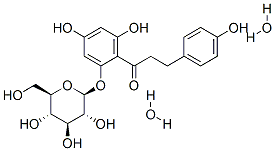Home
Products
Phlorizin



| Product Name | Phlorizin |
| Price: | $15 / 20mg |
| Catalog No.: | CN05676 |
| CAS No.: | 60-81-1 |
| Molecular Formula: | C21H24O10 |
| Molecular Weight: | 436.4 g/mol |
| Purity: | >=98% |
| Type of Compound: | Chalcones |
| Physical Desc.: | Powder |
| Source: | The herbs of Prunus armeniaca L. |
| Solvent: | DMSO, Pyridine, Methanol, Ethanol, etc. |
| SMILES: | OC[C@H]1O[C@@H](Oc2cc(O)cc(c2C(=O)CCc2ccc(cc2)O)O)[C@@H]([C@H]([C@@H]1O)O)O |
| Contact us | |
|---|---|
| First Name: | |
| Last Name: | |
| E-mail: | |
| Question: | |
| Description | Phlorizin is a non-selective SGLT inhibitor with Kis of 300 and 39 nM for hSGLT1 and hSGLT2, respectively. Phlorizin is also a Na+/K+-ATPase inhibitor. |
| Target | Ki: 300 nM (hSGLT1), 39 nM (hSGLT2)[1] Na+/K+-ATPase[2] |
| In Vitro | Phlorizin is a non-selective SGLT inhibitor with Kis of 300 and 39 nM for hSGLT1 and hSGLT2, respectively[1]. Phlorizin is also a Na+/K+-ATPase inhibitor[2]. Phlorizin at 2×10-4 M inhibits Na+ and Rb+-activated ATPase activities in human red cell membranes by 43 %. At 1 mM and 7 mM RbCl, rubidium uptake is not changed or is slightly inhibited (less than 15 %) by 2×10-4 M Phlorizin[2]. Cell viability is not significantly altered by doses of Phlorizin <100 μM. Pretreating cells with Phlorizin does not significantly reduce nitrite or PGE2 levels. Phlorizin does not suppress IL-6 or TNF-α production, although 100 μM Phlorizin can significantly inhibit TNF-α expression[3]. |
| In Vivo | Prior to Phlorizin treatment, the blood glucose level in SDT fatty rats is 370±49 mg/dL. Six hours after dosing, the blood glucose level in the Phlorizin treated group decreases to an almost normal level (139±32 mg/dL). Phlorizin-treated SDT fatty rats are heavier than vehicle-treated SDT fatty rats after 12 weeks. Phlorizin treatment significantly decreases glucose excretion and delays insulin decreases. Creatinine clearance decreases significantly with Phlorizin treatment. 23 weeks of Phlorizin treatment prevents the decrease of nerve fibers (23.6±3.2 fibers/mm). Retinal abnormalities are completely prevented with Phlorizin[4]. |
| Cell Assay | The RAW264.7 murine macrophage-derived cell line is used. Cell viability is measured using the 3-(4,5-Dimethylthiazol-2-yl)-2,5-diphenyltetrazolium bromide (MTT) assay. Cells (105 cells/well) are cultured in 96-well plates and treated with varying concentrations of Phlorizin for 24 h. Next, the supernatant is removed and the cells are incubated with MTT (50 mg/mL) for 4 h at 37°C. The plates are washed and isopropanol is added to dissolve formazone crystals, then the absorbance values are measured at 570 nm using a microplate reader[3]. |
| Animal Admin | Female SDT fatty rats are used in this study. At six weeks of age, SDT fatty rats are divided into two groups (n=8); a Phlorizin treated group and a vehicle treated group. Age-matched female Sprague-Dawley (SD) rats are used as control animals (n=8). Animals are housed in a climate-controlled room (temperature 23±3°C, humidity 55±15%, 12 h lighting cycle) and allowed free access to basal diet and water. Phlorizin is injected subcutaneously once daily (100 mg/kg/day) to animals in the Phlorizin treated group for 23 weeks. Twenty % propylene glycol is administered to animals in the vehicle treated group and control SD rats[4]. |
| Density | 1.6±0.1 g/cm3 |
| Boiling Point | 770.0±60.0 °C at 760 mmHg |
| Flash Point | 270.7±26.4 °C |
| Exact Mass | 436.136932 |
| PSA | 177.14000 |
| LogP | 0.45 |
| Vapour Pressure | 0.0±2.8 mmHg at 25°C |
| Storage condition | 2-8°C |